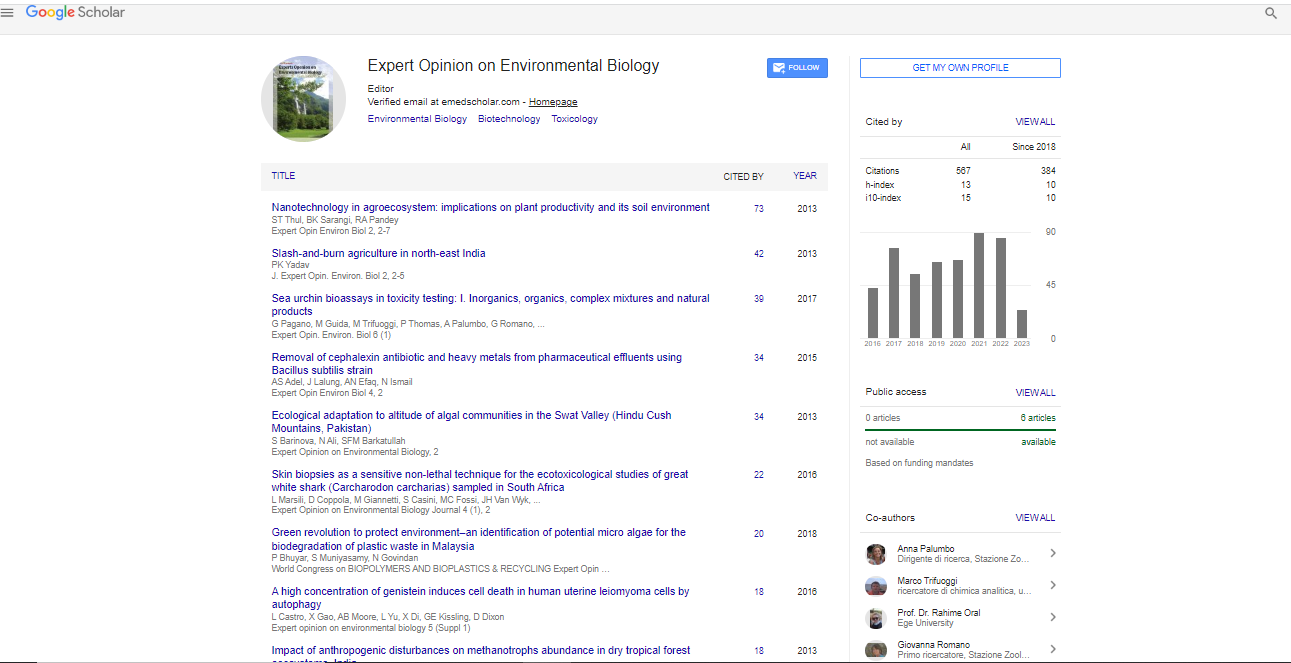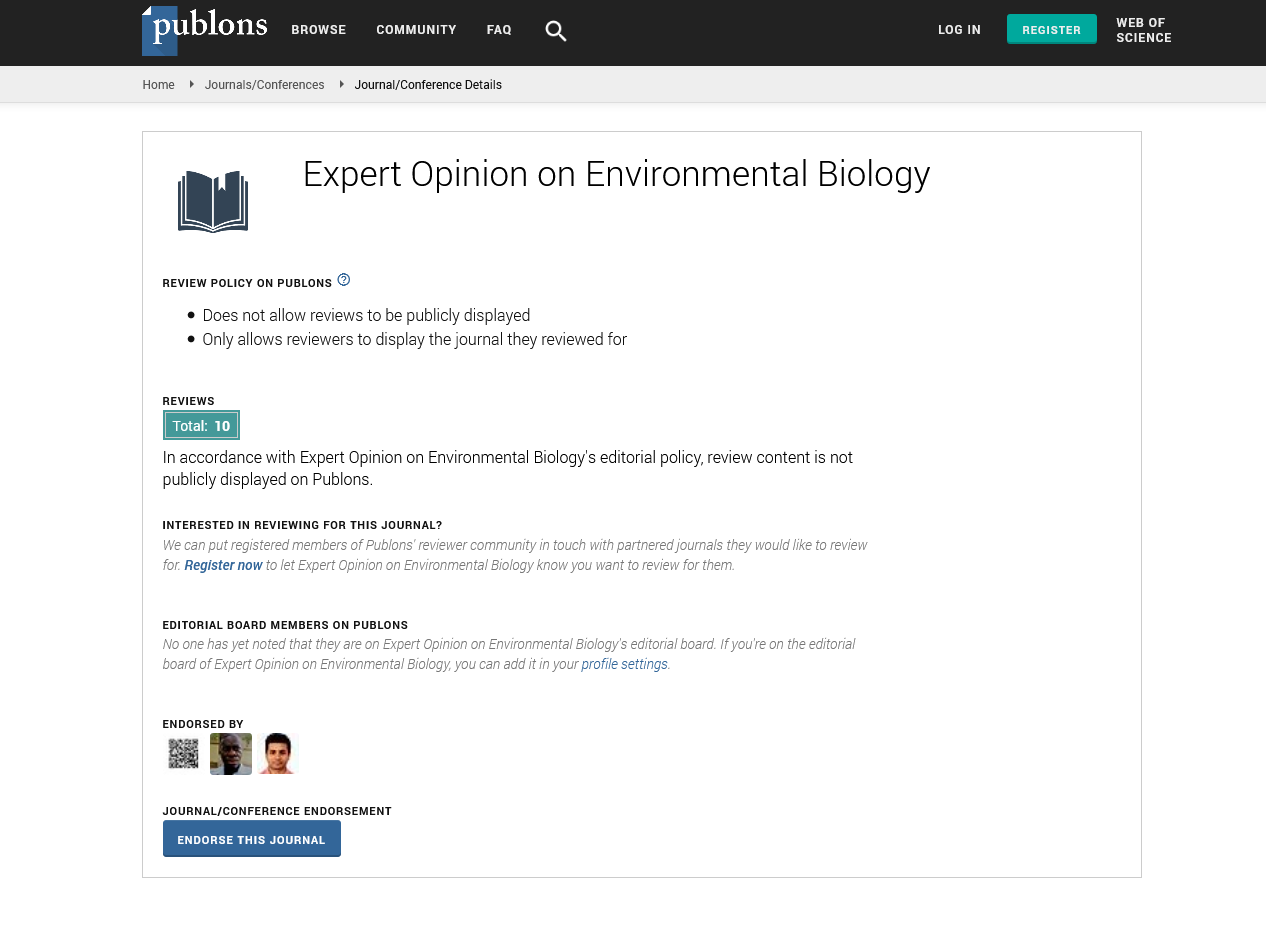Opinion Article, Expert Opin Environ Biol Vol: 14 Issue: 1
Biodiversity Conservation in Wetland Ecosystems: Strategies and Challenges
Davis Lennifer*
Department of Environmental Science, University of New South Wales, Sydney, Australia
- *Corresponding Author:
- Davis Lennifer
Department of Environmental Science, University of New South Wales, Sydney, Australia
E-mail: davis_ lennifer@uns22.au
Received: 01-Mar-2025, Manuscript No. Eoeb-25-169974, Editor assigned: 03-Mar-2025, PreQC No. Eoeb-25-169974 (PQ), Reviewed: 17-Mar-2025, QC No. Eoeb-25-169974, Revised: 21-Mar-2025, Manuscript No. Eoeb-25- 169974 (R), Published: 28-Mar-2025, DOI: 10.4172/ 2325-9655.1000236
Citation: Davis l (2025) Biodiversity Conservation in Wetland Ecosystems: Strategies and Challenges. Expert Opin Environ Biol 14: 236
Copyright: © 2025 Davis L. This is an open-access article distributed under the terms of the Creative Commons Attribution License, which permits unrestricted use, distribution and reproduction in any medium, provided the original author and source are credited.
Abstract
Wetlands are among the most productive and biologically diverse
ecosystems on Earth, providing critical habitats for numerous
species and essential ecological services. However, these
ecosystems face unprecedented threats from habitat loss, pollution,
invasive species, and climate change. This article reviews the
ecological significance of wetlands, highlighting their roles in
biodiversity conservation, nutrient cycling, water purification, and
carbon sequestration. It examines various conservation strategies,
including habitat restoration, protected area designation, sustainable
water management, and community-based stewardship. Challenges
such as balancing human development needs, mitigating pollution
sources, and adapting to climate change impacts are discussed.
The paper underscores the importance of integrated conservation
approaches that combine scientific research, policy frameworks,
and local engagement. Effective wetland conservation not only
safeguards biodiversity but also enhances ecosystem resilience and
sustains human livelihoods dependent on these vital landscapes.
Keywords: Wetlands; Biodiversity conservation; Habitat restoration; Climate change adaptation; Ecosystem services
Keywords
Wetlands; Biodiversity conservation; Habitat restoration; Climate change adaptation; Ecosystem services
Introduction
Wetlands are transitional ecosystems between terrestrial and aquatic environments, characterized by water saturation that supports specialized plant and animal communities. They serve as biodiversity hotspots, providing habitats for migratory birds, amphibians, fish, and numerous invertebrates. Wetlands also deliver crucial ecosystem services, including water filtration, flood control, nutrient retention, and carbon storage. Despite their ecological and economic importance, wetlands are disappearing at alarming rates due to anthropogenic pressures such as land conversion, pollution, and unsustainable resource exploitation. This article explores the ecological importance of wetlands, the conservation strategies employed to protect them, and the challenges that hinder effective management. A focus is placed on integrating scientific knowledge, policy measures, and community participation to ensure long-term wetland sustainability [1].
Description
Wetland biodiversity is shaped by unique hydrological regimes, soil conditions, and nutrient dynamics. Key wetland types include marshes, swamps, bogs, and mangroves, each supporting distinct species assemblages. These ecosystems act as natural buffers, reducing flood impacts, recharging groundwater, and improving water quality.
Conservation strategies
- Protected areas: Establishing national parks, wildlife sanctuaries, and Ramsar sites helps safeguard wetland habitats from encroachment.
- Habitat restoration: Rehabilitation of degraded wetlands through hydrological restoration, native vegetation planting, and removal of invasive species improves ecological function.
- Sustainable water management: Balancing water allocation between human and ecological needs is essential for maintaining wetland hydrology.
- Community engagement: Involving local communities in conservation planning fosters stewardship and promotes sustainable livelihoods compatible with wetland protection.
- Policy and legislation: Enforcing environmental laws and incorporating wetland conservation into land-use planning strengthens protection efforts [2], [3].
Results
Numerous case studies have demonstrated that integrated conservation approaches yield positive biodiversity outcomes. For example, restoration projects in the Mississippi River Delta have increased fish and bird populations, while mangrove replanting in Southeast Asia has enhanced coastal protection and biodiversity. Successful wetland management requires long-term monitoring to adapt to changing ecological conditions and human pressures [4].
Discussion
Despite advances in wetland conservation, challenges remain. Climate change-induced sea-level rise threatens coastal wetlands, while agricultural runoff continues to degrade freshwater wetlands. Addressing these issues requires cross-sector collaboration, innovative financing mechanisms, and greater public awareness. The use of modern technologies such as remote sensing and ecological modelling can aid in mapping wetland extent, monitoring health, and predicting future threats [5].
Conclusion
Wetlands are irreplaceable ecosystems that require urgent and sustained conservation efforts. Strategies combining ecological restoration, policy support, and community participation can effectively halt biodiversity loss in wetlands. By preserving these vital habitats, we not only protect wildlife but also ensure the continued provision of ecosystem services critical to human well-being.
References
- Schneider LS, Dagerman KS, Insel P (2005) Risk of Death with Atypical Antipsychotic Drug Treatment for Dementia. JAMA 294: 1934â??1943.
- Rasmussen K, Sampson S, Rummans T (2002) Electroconvulsive therapy and newer modalities for the treatment of medication-refractory mental illness. Mayo Clin Proc 77: 552â??556.
- Lotrich F, Pollock B (2005) Aging and clinical pharmacology: implications for antidepressants. J Clin Pharmacol 45: 1106â??1122.
- Olesen JB, Hansen PR, Erdal J, Abildstrøm SZ, Weeke P, et al. (2010) Antiepileptic drugs and risk of suicide: a nationwide study. Pharmacoepidem Dr S 19: 518â??524.
- Gill S, Bronskill S, Normand S, Anderson GM, Sykora K, et al. (2007) Antipsychotic drug use and mortality in older adults with dementia. Ann Intern Med 146: 775â??786.
 Spanish
Spanish  Chinese
Chinese  Russian
Russian  German
German  French
French  Japanese
Japanese  Portuguese
Portuguese  Hindi
Hindi 
